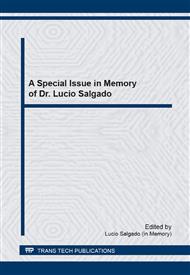p.41
p.47
p.52
p.57
p.61
p.65
p.71
p.77
p.83
Cellular Functionality on Nanotubes of Ti-30Ta Alloy
Abstract:
Recent studies have identified strong correlations between anodized metals and the production of highly biomimetic nanoscale topographies. These surfaces provide an interface of enhanced biocompatibility that exhibits a high degree of oxidation and surface energy. In this study, Human dermal fibroblasts (HDF, neonatal) were utilized to evaluate the biocompatibility of Ti-30Ta nanotubes after 1 day of culture. The anodization process was performed in an electrolyte solution containing HF (48%) and H2SO4 (98%) in the volumetric ratios 1:9 with the addition of 5% dimethyl sulfoxide (DMSO) at 35V for 40 min. Cellular analysis identified improved fibroblast functionality on the nanotube surface, showing increased elongation, and extracellular matrix production on the Ti-30Ta nanotubes. The results presented identify improved cellular interaction on Ti-30Ta nanotubes as compared to the control substrates. Thus, the formation of the nanotube on Ti30Ta alloy may have potential application as interface for implantable devices.
Info:
Periodical:
Pages:
61-64
Citation:
Online since:
September 2014
Keywords:
Price:
Сopyright:
© 2015 Trans Tech Publications Ltd. All Rights Reserved
Share:
Citation:


